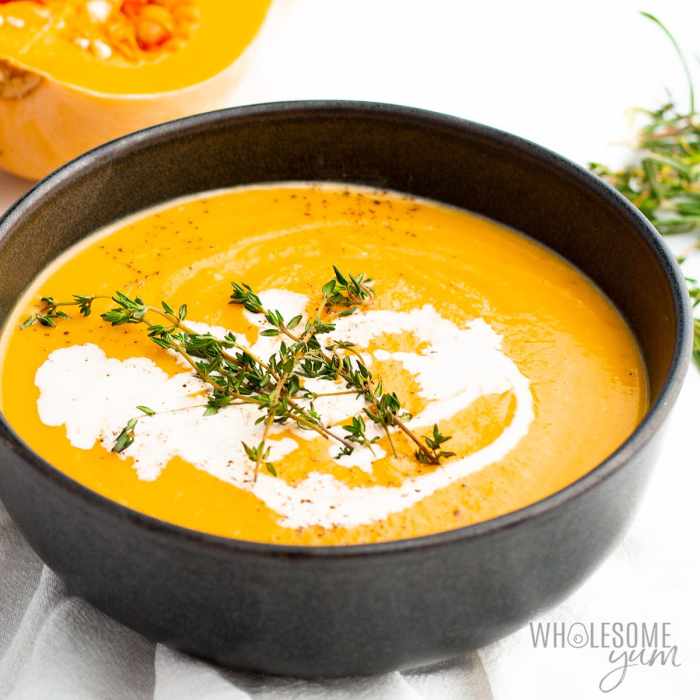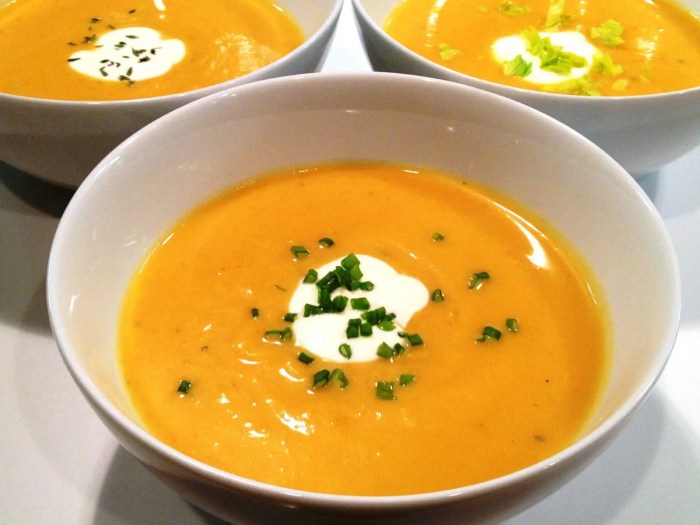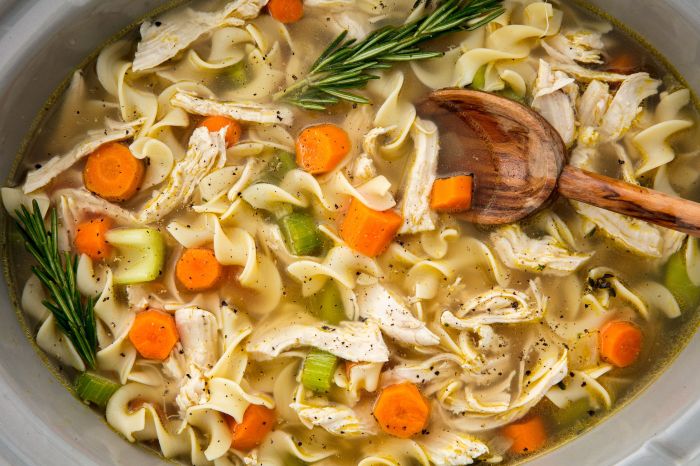Recipe Variations
Butternut potato soup recipe – This recipe for butternut potato soup is incredibly versatile, allowing for customization to suit various dietary needs and preferences. Below are three variations: a classic, a vegan, and a spicy version, each highlighting different flavor profiles and textures. The nutritional information provided is an approximation and may vary depending on specific ingredients used and portion sizes.
Classic Butternut Potato Soup
This version offers a creamy, comforting taste, perfect for a chilly evening. The addition of cream enhances the richness and overall texture.Ingredients: 1 tbsp olive oil, 1 medium onion (chopped), 2 cloves garlic (minced), 1 medium butternut squash (peeled, seeded, and cubed), 2 medium potatoes (peeled and cubed), 4 cups vegetable broth, 1 cup heavy cream, salt and pepper to taste.Instructions: Sauté onion and garlic in olive oil until softened.
Add butternut squash and potatoes, and cook for a few minutes. Pour in vegetable broth, bring to a boil, then reduce heat and simmer until vegetables are tender. Blend until smooth. Stir in heavy cream and season with salt and pepper.
Vegan Butternut Potato Soup
This variation replaces the dairy cream with coconut milk for a rich and creamy texture without any animal products.Ingredients: 1 tbsp olive oil, 1 medium onion (chopped), 2 cloves garlic (minced), 1 medium butternut squash (peeled, seeded, and cubed), 2 medium potatoes (peeled and cubed), 4 cups vegetable broth, 1 can (13.5 oz) full-fat coconut milk, salt and pepper to taste, 1 tbsp nutritional yeast (for cheesy flavor).Instructions: Follow the same instructions as the classic version, substituting the heavy cream with coconut milk and adding nutritional yeast for a cheesy flavor.
Spicy Butternut Potato Soup
This version adds a kick with the inclusion of chili flakes and a touch of chipotle powder for a smoky heat.Ingredients: 1 tbsp olive oil, 1 medium onion (chopped), 2 cloves garlic (minced), 1 medium butternut squash (peeled, seeded, and cubed), 2 medium potatoes (peeled and cubed), 4 cups vegetable broth, 1/2 cup heavy cream (or coconut milk for vegan option), 1/2 tsp red pepper flakes, 1/4 tsp chipotle powder, salt and pepper to taste.Instructions: Follow the instructions for the classic version, adding red pepper flakes and chipotle powder along with the vegetable broth.
Stir in cream (or coconut milk) and season.
Nutritional Information Comparison
The following table provides an estimated nutritional comparison per serving (approximately 1.5 cups) for each variation. These values are approximations and may vary.
| Classic | Vegan | Spicy | |
|---|---|---|---|
| Calories | 350 | 300 | 360 |
| Fat (g) | 20 | 15 | 21 |
| Protein (g) | 7 | 6 | 7 |
| Carbohydrates (g) | 45 | 50 | 43 |
Image Descriptions
Classic Butternut Potato Soup: A vibrant, golden-hued soup with a smooth, velvety texture. Steam gently rises from the surface, hinting at its warmth. The color is rich and inviting, with subtle variations in tone reflecting the butternut squash and potatoes.Vegan Butternut Potato Soup: The soup maintains a similar creamy texture to the classic version, but the color is slightly paler, a warm, light orange.
The coconut milk imparts a subtle sheen to the surface.Spicy Butternut Potato Soup: This soup retains the creamy texture but has a deeper, more intense orange hue due to the chili flakes. Tiny flecks of red pepper are visible throughout, hinting at the underlying heat. The overall appearance is rich and slightly more rustic.
Ingredient Sourcing and Preparation
Creating a truly delicious butternut potato soup hinges on selecting and preparing high-quality ingredients. The careful choice of potatoes and butternut squash, along with their proper preparation, significantly impacts the final flavor and texture of the soup. Paying attention to these details elevates this simple dish to something truly special.The best potatoes to complement the sweetness of butternut squash are those with a subtly earthy and starchy profile.
Their texture should hold up well during cooking, preventing the soup from becoming overly mushy.
Potato Selection and Preparation
Russet potatoes, with their fluffy texture and slightly sweet flavor, are an excellent choice. Yukon Gold potatoes offer a creamier texture and a richer, buttery flavor, providing a lovely contrast to the squash. Avoid waxy potatoes like red potatoes, as they tend to hold their shape too well and can result in a less smooth soup. For preparation, thoroughly wash the potatoes and peel them using a vegetable peeler.
Cut the peeled potatoes into roughly one-inch cubes for even cooking.
Butternut Squash Selection and Storage
Selecting a ripe butternut squash is crucial for optimal flavor and ease of preparation. Look for a squash that is heavy for its size, with firm, smooth skin and a deep orange-yellow color. Avoid squashes with bruises, soft spots, or blemishes. Once you’ve chosen your squash, store it in a cool, dry, and well-ventilated area, such as a pantry or basement.
Proper storage can extend its shelf life for several weeks.
Butternut Squash Preparation
Preparing the butternut squash involves several steps. First, thoroughly wash the squash under cold running water. Then, using a sharp knife, carefully cut the squash in half lengthwise. Scoop out the seeds and stringy pulp using a spoon. Next, peel the skin using a vegetable peeler or a sharp knife, being careful not to cut yourself.
Finally, cut the peeled squash into roughly one-inch cubes, ensuring consistent sizing for even cooking.
Cooking Methods and Techniques

Source: wholesomeyum.com
This section explores different methods for preparing butternut potato soup, comparing their advantages and disadvantages, and detailing techniques for achieving optimal creaminess and avoiding common pitfalls. We’ll examine stovetop and slow cooker methods, then discuss the use of immersion and regular blenders for achieving the desired texture.
Stovetop versus Slow Cooker Methods
The stovetop and slow cooker offer distinct approaches to making butternut potato soup. The stovetop method provides more immediate control over the cooking process, allowing for adjustments to consistency and flavor as the soup simmers. This method is generally faster, ideal for weeknight meals. However, it requires more active attention, demanding occasional stirring to prevent sticking and burning.
The slow cooker, conversely, offers a hands-off approach. Ingredients are combined, and the slow cooker does the rest, resulting in a deeply flavorful soup. However, the cooking time is significantly longer, and the texture might be slightly less refined than that achieved on the stovetop. The slow cooker’s gentler heat can also result in a slightly less vibrant color.
Achieving a Smooth and Creamy Texture
Achieving a luxuriously smooth and creamy texture is key to a great butternut potato soup. Two primary tools facilitate this: the immersion blender and the regular blender. An immersion blender allows for direct blending within the pot, eliminating the need for transferring the hot soup. This minimizes the risk of burns and splashing. The result is a consistently smooth texture throughout the soup.
Using a regular blender, on the other hand, requires careful portioning and blending in batches to avoid overloading the blender and potential burns from hot liquids. While a regular blender can achieve a very smooth puree, there’s a slight risk of a less uniform texture if not carefully done, and the transfer process adds extra steps.
Common Mistakes and Their Rectifications
Several common mistakes can detract from the quality of your butternut potato soup. Understanding these mistakes and their solutions can ensure a consistently delicious outcome.
- Overcooking the butternut squash: Overcooked squash becomes mushy and loses its flavor. Ensure the squash is cooked until tender but still retains some structure. Adjust cooking time accordingly based on the size of the squash pieces.
- Not roasting the squash: Roasting the squash before adding it to the soup enhances its sweetness and depth of flavor. This step is highly recommended for a superior taste.
- Using too much liquid: This results in a thin, watery soup. Start with less liquid and add more gradually until you achieve the desired consistency.
- Incorporating cold ingredients: Adding cold ingredients, like dairy, to a hot soup can cause it to curdle. Always add cold ingredients gradually and stir continuously.
- Forgetting seasoning: Seasoning is crucial for balancing the flavors. Taste the soup frequently and adjust seasonings as needed. Don’t be afraid to experiment with herbs and spices.
Flavor Enhancement and Serving Suggestions

Source: perfectlyprovence.co
Elevating the simple pleasures of butternut potato soup involves exploring diverse flavor profiles and creative serving methods. The following suggestions aim to transform a comforting classic into a truly memorable culinary experience. Careful consideration of flavor pairings and presentation can significantly enhance the overall enjoyment of this dish.
Unique Flavor Combinations
Adding unexpected ingredients can dramatically alter the flavor profile of butternut potato soup, creating exciting and nuanced taste experiences. The following combinations offer distinct flavor journeys, ranging from subtly spiced to richly indulgent.
- Smoked Paprika and Chipotle Peppers: This combination introduces a smoky depth and a subtle heat, complementing the sweetness of the butternut squash and potato. The smoky paprika provides a rich, earthy note, while the chipotle peppers add a gentle warmth without overpowering the other flavors. The result is a sophisticated and warming soup perfect for cooler evenings.
- Thai Green Curry Paste and Coconut Milk: This creates a fragrant and creamy soup with a distinct Southeast Asian flair. The green curry paste adds a complex blend of herbs and spices, including lemongrass, galangal, and chilies, creating a vibrant and aromatic soup. The coconut milk contributes a rich, creamy texture and a subtle sweetness that balances the spice.
- Rosemary and Sage with Toasted Pepitas: This option offers a herbaceous and nutty twist. The rosemary and sage provide a robust, earthy aroma and flavor, complementing the natural sweetness of the soup. Toasted pepitas (pumpkin seeds) add a satisfying crunch and a nutty flavor that enhances the overall texture and taste.
- Harissa Paste and Toasted Almonds: This combination introduces a North African influence, with the harissa paste adding a vibrant, spicy kick. The harissa paste’s blend of chilies, spices, and herbs creates a complex and flavorful soup. Toasted almonds add a pleasant crunch and a nutty counterpoint to the spice.
- Maple Syrup and Toasted Pecans: This pairing offers a sweet and savory combination, highlighting the natural sweetness of the butternut squash. The maple syrup adds a touch of refined sweetness, while the toasted pecans provide a delightful crunch and a rich, buttery flavor. This option is particularly appealing for those who enjoy sweeter soups.
Creative Serving Suggestions
Moving beyond the standard bowl, creative serving methods can significantly elevate the presentation and dining experience of butternut potato soup. The following suggestions offer unique ways to serve this classic dish.
- Miniature Soup Shooters: Serve the soup in elegant shot glasses or small espresso cups. This presentation is perfect for appetizers or a more refined setting. Garnish with a swirl of cream and a sprinkle of finely chopped chives for an upscale look.
- Bread Bowls: Hollow out crusty bread bowls and fill them with the warm soup. This rustic presentation is both visually appealing and provides a delicious edible vessel. Consider using a sourdough or a hearty artisan bread for optimal texture and flavor.
- Grilled Cheese Pairing: Serve the soup alongside a gourmet grilled cheese sandwich. This classic combination is both comforting and satisfying. Use high-quality cheese such as Gruyere or Fontina, and add caramelized onions or roasted red peppers for extra flavor and visual appeal.
Garnish Options, Butternut potato soup recipe
Garnishes not only enhance the visual appeal of the soup but also add another layer of flavor and texture. Careful selection of garnishes can significantly impact the overall dining experience.
| Garnish | Flavor Profile | Visual Impact | Texture |
|---|---|---|---|
| Croutons | Savory, slightly crisp, sometimes herbed | Adds texture and color contrast | Crunchy |
| Chives | Mild onion flavor, fresh and herbaceous | Adds pops of bright green color | Delicate |
| Roasted Pumpkin Seeds | Nutty, slightly sweet, earthy | Adds earthy tones and textural contrast | Crunchy |
| Fresh Parsley | Bright, herbaceous, slightly peppery | Adds a fresh, vibrant green accent | Soft |
Recipe Scaling and Storage
This section details how to adjust the butternut potato soup recipe for different serving sizes and provides guidance on proper storage and reheating to maintain optimal flavor and texture. Knowing how to scale a recipe is crucial for both large gatherings and smaller households, while proper storage ensures you can enjoy the delicious soup for days to come.Scaling the recipe is straightforward, involving proportional adjustments to all ingredients.
For instance, a recipe designed for 4 servings can easily be doubled to serve 8, or halved to serve just 2. This involves multiplying or dividing each ingredient quantity by the appropriate scaling factor (2 for doubling, 0.5 for halving).
Recipe Scaling Examples
To illustrate, let’s assume a recipe for 4 servings calls for 1 medium butternut squash, 2 medium potatoes, 4 cups of vegetable broth, and 1 cup of heavy cream.
- To double the recipe (serves 8): Use 2 medium butternut squash, 4 medium potatoes, 8 cups of vegetable broth, and 2 cups of heavy cream.
- To halve the recipe (serves 2): Use ½ medium butternut squash (or a smaller squash), 1 medium potato, 2 cups of vegetable broth, and ½ cup of heavy cream. You may need to adjust the potato quantity slightly depending on the size.
Remember to adjust cooking time accordingly when scaling the recipe. Larger batches will generally require a longer cooking time, while smaller batches may cook more quickly.
Storing Leftover Butternut Potato Soup
Proper storage is essential for preserving the quality and safety of leftover butternut potato soup. Allow the soup to cool completely before storing. This prevents condensation build-up which can lead to bacterial growth. The best containers for storage are airtight containers made of glass or food-grade plastic. Avoid using metal containers, as they can affect the flavor of the soup.
Optimal Storage and Shelf Life
Stored correctly in an airtight container in the refrigerator, butternut potato soup will typically remain safe and flavorful for 3-5 days. After this period, it’s best to discard any remaining soup.
Freezing Butternut Potato Soup
Freezing is an excellent method for extending the shelf life of butternut potato soup. Allow the soup to cool completely before freezing it in airtight freezer-safe containers, leaving some headspace to accommodate expansion during freezing. Frozen butternut potato soup can generally be stored for 2-3 months. The texture might slightly change after freezing and thawing, but the flavor will remain largely intact.
Reheating Butternut Potato Soup
When reheating, avoid boiling the soup, as this can cause the potatoes to become mushy and affect the overall texture. Instead, gently heat the soup over medium-low heat on the stovetop, stirring occasionally, until it’s thoroughly heated through. Alternatively, you can reheat individual portions in the microwave, but be mindful of uneven heating and stir frequently to prevent scorching.
FAQ Section: Butternut Potato Soup Recipe
Can I use other types of squash?
Yes, other winter squashes like kabocha or acorn squash can be substituted for butternut squash, although the flavor profile will differ slightly.
How long does the soup last in the refrigerator?
Properly stored in an airtight container, leftover butternut potato soup will typically last for 3-4 days in the refrigerator.
Can I freeze butternut potato soup?
Yes, butternut potato soup freezes well. Allow it to cool completely before storing in freezer-safe containers for up to 3 months.
What if my soup is too thick?
Thin the soup by adding a little broth, milk, or cream until you reach your desired consistency.
What if my soup is too thin?
Simmer the soup uncovered for a while to reduce the liquid and thicken the consistency. Alternatively, you can blend in a roux (butter and flour mixture) for a creamier texture.


